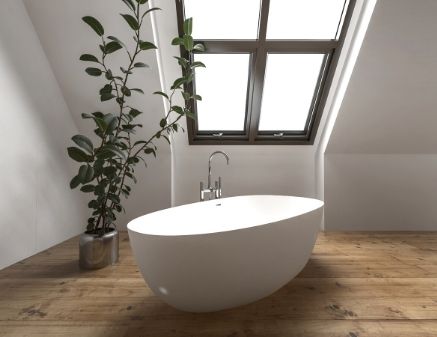Have you ever dreamt of bringing the warm, timeless elegance of hardwood flooring into your bathroom? The image might seem luxurious and inviting, but the practicality of it can make you raise eyebrows. A bathroom is a place that gets wet, and water can ruin beautiful hardwood. But what if there were ways to overcome those hurdles and make your dream a reality? This guide is designed to equip you with the knowledge you need to make an informed decision about whether hardwood floors are right for your bathroom, and if so, how to make it a successful and long-lasting project.

Image: www.fromtheforest.com
From the classic elegance of a traditional bathroom to the modern minimalist aesthetic, hardwood floors bring a level of sophistication hard to find with other materials. But with the constant presence of moisture, humidity, and splashes, you might be wondering if it’s even possible. The good news is, with careful planning and the right products, you can enjoy the beauty of hardwood floors in your bathroom without sacrificing functionality.
Exploring the Challenges and Solutions
The key to success lies in understanding the specific challenges of installing hardwood in a bathroom and finding the right solutions. Let’s dive into the common concerns and how to address them:
1. Water Resistance: Hardwood, by its very nature, is porous and can be vulnerable to water damage. This is the biggest concern for bathrooms, where spills, showers, and even just humidity can create the perfect recipe for warped, rotten, and damaged floors.
Solution: The answer here is selecting the right type of hardwood. While solid hardwood is beautiful, it’s generally not recommended for bathrooms. Engineers, architects, and flooring experts strongly advise using engineered hardwood, which features a sturdy base plywood core topped with a veneer of real hardwood. This construction makes engineered hardwood far more dimensionally stable, better equipped to withstand changes in humidity, and less susceptible to warping.
2. Moisture Barriers: Even with engineered hardwood, you need to protect it from excessive moisture.
Solution: A proper moisture barrier is essential. This can involve several layers of protection:
- Vapor barrier: Laying a vapor barrier (such as plastic sheeting) beneath the subfloor prevents moisture from migrating up from the ground.
- Waterproof underlayment: The underlayment goes directly beneath the hardwood planks, providing an additional layer of protection against moisture.
3. Installation Techniques: The installation process itself plays a crucial role in the longevity of your hardwood floors.
Solution: Using a floating installation method is highly recommended for bathrooms. This method involves installing the planks without nailing or gluing them to the subfloor, allowing for slight movement as the wood expands and contracts with humidity changes. It’s important to leave a small gap (expansion gap) between the hardwood planks and the walls to accommodate this movement.
4. Finishing Touches: The finish you choose for your hardwood floor can affect its water resistance.
Solution: Look for finishes with high levels of polyurethane or acrylic sealants. These sealants create a protective layer that repels water and moisture, keeping your hardwood safe. Opting for a satin or semi-gloss finish can also enhance water resistance.
Choosing the Right Hardwood for Your Bathroom
-
Wood Species: Certain wood species are naturally more resistant to moisture than others. Hardwoods like oak, maple, cherry, and walnut are known for their durability and work well in bathrooms, especially when paired with engineered construction. Teak is another excellent option for bathroom floors as it contains natural oils that make it resistant to water and rot.
-
The Right Finish: The finish is a critical element. A good quality, moisture-resistant polyurethane or acrylic sealant is essential. Avoid oil-based finishes, as they can be more susceptible to water damage and take longer to dry.
-
Engineered Hardwood: Engineered hardwood is the preferred choice for bathroom installation. The multi-layer construction offers superior stability and reduces the risk of warping or cupping.
Maintaining Your Bathroom Hardwood Floors
Even with proper installation and materials, regular maintenance is key to keeping your hardwood floors looking their best in your bathroom:
- Clean Regularly: Sweep or vacuum your bathroom floors regularly to remove dirt and debris that can trap moisture.
- Clean Spills Quickly: Act fast when spills happen. Clean up water or other liquids immediately to avoid potential damage.
- Avoid Harsh Cleaners: Use mild cleaners made specifically for hardwood floors. Harsh chemicals can strip the finish and leave the wood vulnerable.
- Protect from Scratches: Use rugs or mats in high-traffic areas to prevent scratches from footwear.
- Reapply Finish: Periodically reapply a layer of sealant to maintain the protective barrier and keep the wood looking beautiful.
/hardwoodbathroom-588f341e3df78caebccc9ec2.jpg)
Image: flooring.about.com
Can You Put Hardwood Floors In A Bathroom
Conclusion: Making Your Dream a Reality
Adding hardwood floors to your bathroom can transform the space into a luxurious haven. But, it’s essential to take the necessary precautions to ensure the longevity of your investment. Choosing engineered hardwood, using proper moisture barriers, and employing expert installation techniques combined with careful maintenance are all crucial for a successful outcome.
If you’re considering hardwood floors for your bathroom, do your research, consult with a professional, and choose the right materials and techniques. Then, with a little planning and care, you can enjoy the beauty and elegance of hardwood in your bathroom for years to come.






